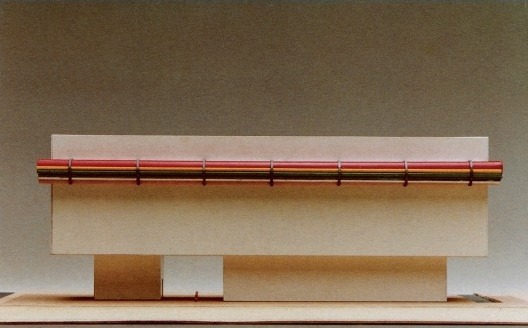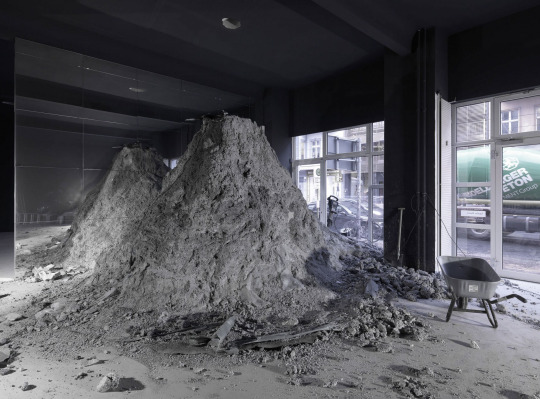ulterior spaces [email protected]
Last active 60 minutes ago
Don't wanna be here? Send us removal request.
Text

Lina Bo Bardi, Brazilian pavilion, World Expo Seville 1992
1 note
·
View note
Text


Today, when we think about Venice, we conjure up a small peninsula in the northern Adriatic. It is hard to imagine that Venetians were able to rule such a vast cultural space. The key was their legendary mobility. They were always on the move. The Republic built on the water developed its eclectic cultural influence through its enduring presence in the Adriatic and the Mediterranean. The city was the final destination for the most important cultural and caravan route between the Orient and the Occident. No wonder The World Theater united in itself several references: Renaissance and Elizabethan theaters, lighthouse architecture, Venetian floating architecture, and temporary structures built for the carnival. [3] As Nadine Labedade wrote "Thus, it is the typology of the city that creates the scenario. And this mobile theater-boat became a fragment of the urban history, a quasi-metaphysical image tasked with representing architecture.” ... There were just a few performances in the floating Teatro del Mondo that Rossi built for the Venice Biennale in 1979. After the short display in the lagoon and the voyage across the Adriatic to the Croatian city of Dubrovnik, the temporary theatre was disassembled. Nevertheless, this scenography-like building shaped the Italian architecture of the second half of the 20th century like no other project. The relocation to Dubrovnik, the famous medieval Republic and archrival of Venice in the Adriatic, inspired discussion about eclectic cultural influence and the complex historical layers of Adriatic cities. Those years coincided with the beginning of the Postmodern movement in former Yugoslavia. It probably was not Rossi’s primary focus of attention, but this Trojan Horse disguised as a theater that was shipped to Dubrovnik, was the first step in a politically delicate debate and movement towards a revision of Modernism in Yugoslavia - no easy feat in the ideologically colored cultural character of a country unconditionally committed to Modernism. Theater as a revolutionary tool in urban planning? Notabene: in 1956 the city of Dubrovnik even hosted CIAM X, the congress. which saw the start of the Team 10.
Source: Teatro del Mondo: An Odyssey
1 note
·
View note
Text

Lawrence Weiner, A 36” X 36” Removal to the lathing or support wall of plaster or wallboard from wall, 1968
0 notes
Text






Daniel Turner, (WHSC 44102 Burnish), 2018, Stainless steel burnished, Provenance- (WAMC) Psychiatric Facility
Daniel Turner, (WHSC 44102.17 Bar), 2018, Cast aluminium, stainless steel, Provenance- (WAMC) Psychiatric Facility
Daniel Turner, Processing a psychiatric facility, 2016-2021
Daniel Turner, 30/30, 2021, Stainless steel burnished, treated panel. Provance/ (WAMC) Psychiatric Facility
"Turner now works primarily in sculpture often involving the creation or transformation of materials, objects and environments into architectural or ephemeral forms. His sculptures are often characterized by a specific response to site under a controlled set of processes. As the artist says “I work specific to the site because the site itself is very important to me. I’m speaking in terms of exhibition context (site) as well as the extraction of material from a given provenance (site). Site activates work and of course work activates site. There is a harmonious marriage between the two and when in tune, a particular lift occurs”. This approach has enabled Turner to base form on transposition, preserving a sensory link to geographical locations, cultural associations and human contact. These elements are present in works where an entire waiting room is cast into a series of solid bars, a former psychiatric facility burnished to a darkened stain against a wall, or a cafeteria dissolved across the expanse of a floor. In 2019, Turner extracted one metric ton of hospital beds from The Vinnitsa Regional Psychoneurological Hospital in Vinnitsa Ukraine which were archived, melted and recast into two solid forms. For “Three Sites” his first institutional solo exhibition in Switzerland, he is creating a new body of site responsive sculptures. Each is made from elements extracted from sites in the Basel region that triangulate between architecture and psychology, including a former psychiatric care facility as well as chemical and pharmaceutical industry buildings. Present and past overlap ceaselessly. These two temporalities are never still, as the artist strives to entangle them even further through various degrees of object metamorphosis, sometimes intervening himself directly in situ. These artefacts are made all the more elusive by the fact that they belong to a standardised, industrial and ready-made universe, devoid of warmth, almost clinical; at first glance, they seem affectless, enabling nothing to transpire of their autobiographical resonance. It is the case with the burnishes on wooden panels produced with stainless steel wool applied by hand. As evanescent as they are informal, the subtle chromatic traces composing blurred masses with erratic outlines betray nothing of the repurposed material’s true genealogy. And yet, this steel wool was produced out of metallic chairs gleaned from an American psychiatric institution. A way of reinjecting meaning, all the while retaining a sense of reserve, in materials that wouldn’t be suspected of harbouring such energy."
0 notes
Text

Cy Twombly, Bacchus, Eiserner Vorhang (Iron Curtain), Vienna State Opera, 2010-11.jpeg
5 notes
·
View notes
Text




One Year Performance 1983–1984 (also known as Rope Piece) was a performance by Hsieh and the artist Linda Montano
1 note
·
View note
Photo

Mike Kelley 'Repressed Spatial Relationships Rendered as Fluid, No. 6: St. Mary's Church and School (Cry Room in the Sky'), 2002
0 notes
Photo

immurement Anchorites: Medieval Women And Men Walled Up Alive
In Christianity, an anchorite or anchoret (female: anchoress) is someone who, for religious reasons, withdraws from secular society so as to be able to lead an intensely prayer-oriented, ascetic, or Eucharist-focused life. While anchorites are frequently considered to be a type of hermit, unlike hermits they were required to take a vow of stability of place, opting for permanent enclosure in cells often attached to churches. Also unlike hermits, anchorites were subject to a religious rite of consecration that closely resembled the funeral rite, following which they would be considered dead to the world, a type of living saint. Anchorites had a certain autonomy, as they did not answer to any ecclesiastical authority other than the bishop.
Though set apart from the community at large by stone walls and specific spiritual precepts, the anchorite lay at the very centre of the community. The anchorhold has been called a communal "womb" from which would emerge an idealized sense of a community's own reborn potential, both as Christians and as human subjects
0 notes
Photo

Santiago Sierra, Removal of a museum’s glass windows, 3 October through 7 November 2004 in Museum Dhondt-Dhaenens, Deurle, Belgium. – Photo Guy Braeckman
0 notes
Photo




Santiago Sierra, Wall enclosing a space, Spanish Pavilion at the Venice Biennale, 2003
“A nation is actually nothing; countries don’t exist. When astronauts went into space they did not see a line between France and Spain; France is not painted pink and Spain blue. They are political constructions, and what’s inside a construction? Whatever you want to put there. And in fact the pavilion wasn’t empty: there were leftovers there from previous shows. It was an act of respect to the history of the place. But the work was also the people who were passing by it. The piece was not the empty space but rather the situation.“
0 notes
Photo




Santiago Sierra, Construction and installation of 12 forms of 76x75x800cm organized in two spaces, 2002
“for the opening of this gallery, new space built in the area in the former East Berlin, that has undergone a strong process of reurbanisation, these forms very constructed out of wood plaster and asphalt. They were installed through the windows and protruded a metre and a half which meant they had to be dismantled. Furthermore, one of the rooms had a different number of windows to the other and two holes had to be made in the wall at the same height where the windows would have been. Another room didn’t have enough space for these forms and holes also had to be made in the wall. In general, the order decided upon for these forms involved intrusive installation for each of the rooms.“
0 notes
Photo



Santiago sierra, ONE PERSON, 2005
Inside the Galleria Civica di Arte Contemporanea, Trento, Italy, a 300m long, 70cm wide, 190cm high corridor was erected.
0 notes
Photo

Fujiko Nakaya. Nebel Leben installation view at Haus der Kunst, Munich, 2022
0 notes
Photo




Archipel, exhibition by n.b.k. and KOW with Arno Brandlhuber
4 notes
·
View notes




